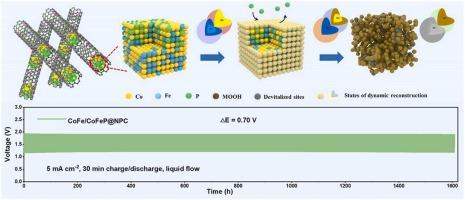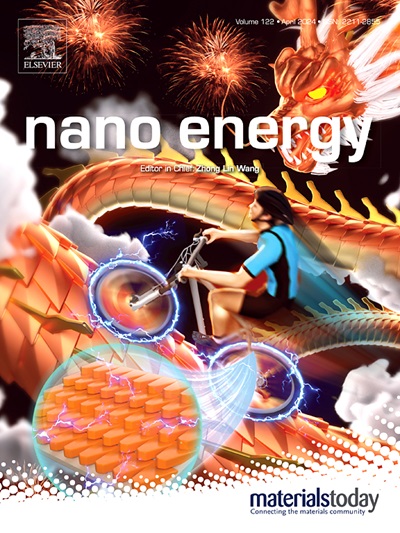In situ reconstruction of bimetallic heterojunctions encapsulated in N/P co-doped carbon nanotubes for long-life rechargeable zinc-air batteries
IF 17.1
1区 材料科学
Q1 CHEMISTRY, PHYSICAL
引用次数: 0
Abstract
Efficient and stable bifunctional electrocatalysts are crucial for the oxygen reduction reaction (ORR) and oxygen evolution reaction (OER) in high-performance rechargeable zinc-air batteries (ZABs). Despite significant advancements in non-noble metal-based catalysts over the past decades, the rational tuning of various active materials for efficient ORR and OER, along with the identification of genuine active sites, remains a formidable challenge. Encouraged by the development of in-situ characterization technologies, research on bifunctional catalysts for ZABs has gradually shifted to exploring the true active sites and investigating catalyst evolution and degradation, which is vital for further breakthroughs in bifunctional catalysts. In this study, we developed a facile method to encapsulate bimetallic heterojunction CoFe/CoFeP in N/P co-doped carbon nanotubes (CNTs) as a bifunctional catalyst for ZABs. This unique heterojunction structure prevents the dissolution and erosion of transition metals, enhances continuous electron transfer and mass transport, and effectively boosts the catalyst's bifunctional activity and stability. Importantly, ex-situ and in-situ techniques were employed to track the dynamic ORR and OER catalytic processes, capture the reconstructions of bifunctional catalysts, and reveal the real active sites. The CoFe/CoFeP@NPC catalyst exhibits superior bifunctional catalytic activity and stability, especially with a half-wave potential of 0.887 V for ORR and 1.55 V at 10 mA cm−2 for OER. Impressively, the assembled rechargeable ZABs demonstrate a high-power density (550 mW cm−2), a low charge-discharge voltage difference (0.7 V), and ultralong cycling for over 1600 h.

用于长寿命锌-空气充电电池的 N/P 共掺碳纳米管中封装的双金属异质结的原位重构
高效稳定的双功能电催化剂对于高性能可充电锌空气电池(ZAB)中的氧还原反应(ORR)和氧进化反应(OER)至关重要。尽管过去几十年来非贵金属基催化剂取得了重大进展,但如何合理调整各种活性材料以实现高效 ORR 和 OER,以及识别真正的活性位点,仍然是一项艰巨的挑战。在原位表征技术发展的推动下,对 ZABs 双功能催化剂的研究逐渐转向探索真正的活性位点以及研究催化剂的演化和降解,这对双功能催化剂的进一步突破至关重要。在本研究中,我们开发了一种简便的方法,将双金属异质结 CoFe/CoFeP 封装在 N/P 共掺杂碳纳米管(CNTs)中,作为 ZABs 的双功能催化剂。这种独特的异质结结构可防止过渡金属的溶解和侵蚀,增强电子转移和质量传输的连续性,并有效提高催化剂的双功能活性和稳定性。重要的是,我们采用了原位和原位技术来跟踪动态 ORR 和 OER 催化过程,捕捉双功能催化剂的重构,并揭示真正的活性位点。CoFe/CoFeP@NPC 催化剂表现出卓越的双功能催化活性和稳定性,尤其是 ORR 的半波电位为 0.887 V,OER 在 10 mA cm-2 时的半波电位为 1.55 V。令人印象深刻的是,组装好的可充电 ZAB 具有高功率密度(550 mW cm-2)、低充放电电压差(0.7 V)和超过 1600 小时的超长循环。
本文章由计算机程序翻译,如有差异,请以英文原文为准。
求助全文
约1分钟内获得全文
求助全文
来源期刊

Nano Energy
CHEMISTRY, PHYSICAL-NANOSCIENCE & NANOTECHNOLOGY
CiteScore
30.30
自引率
7.40%
发文量
1207
审稿时长
23 days
期刊介绍:
Nano Energy is a multidisciplinary, rapid-publication forum of original peer-reviewed contributions on the science and engineering of nanomaterials and nanodevices used in all forms of energy harvesting, conversion, storage, utilization and policy. Through its mixture of articles, reviews, communications, research news, and information on key developments, Nano Energy provides a comprehensive coverage of this exciting and dynamic field which joins nanoscience and nanotechnology with energy science. The journal is relevant to all those who are interested in nanomaterials solutions to the energy problem.
Nano Energy publishes original experimental and theoretical research on all aspects of energy-related research which utilizes nanomaterials and nanotechnology. Manuscripts of four types are considered: review articles which inform readers of the latest research and advances in energy science; rapid communications which feature exciting research breakthroughs in the field; full-length articles which report comprehensive research developments; and news and opinions which comment on topical issues or express views on the developments in related fields.
 求助内容:
求助内容: 应助结果提醒方式:
应助结果提醒方式:


